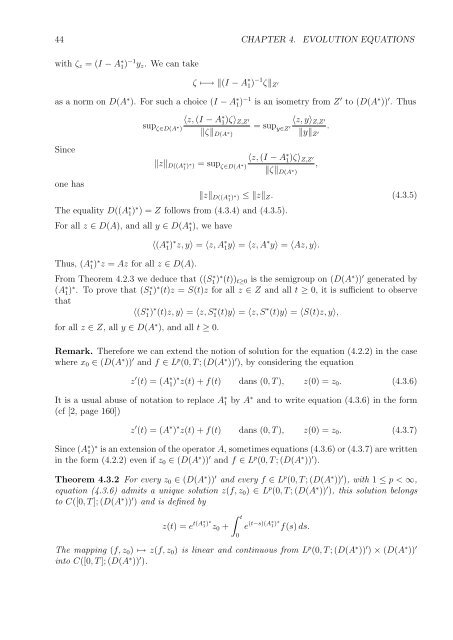Optimal Control of Partial Differential Equations
Optimal Control of Partial Differential Equations
Optimal Control of Partial Differential Equations
You also want an ePaper? Increase the reach of your titles
YUMPU automatically turns print PDFs into web optimized ePapers that Google loves.
44 CHAPTER 4. EVOLUTION EQUATIONS<br />
with ζz = (I − A ∗ 1) −1 yz. We can take<br />
ζ ↦−→ (I − A ∗ 1) −1 ζZ ′<br />
as a norm on D(A ∗ ). For such a choice (I − A ∗ 1) −1 is an isometry from Z ′ to (D(A ∗ )) ′ . Thus<br />
Since<br />
one has<br />
〈z, (I − A<br />
supζ∈D(A∗ )<br />
∗ 1)ζ〉Z,Z ′<br />
ζD(A∗ )<br />
zD((A ∗ 1 )∗ ) = sup ζ∈D(A ∗ )<br />
= sup y∈Z ′<br />
〈z, y〉Z,Z ′<br />
yZ ′<br />
〈z, (I − A∗ 1)ζ〉Z,Z ′<br />
,<br />
ζD(A ∗ )<br />
The equality D((A ∗ 1) ∗ ) = Z follows from (4.3.4) and (4.3.5).<br />
For all z ∈ D(A), and all y ∈ D(A ∗ 1), we have<br />
Thus, (A ∗ 1) ∗ z = Az for all z ∈ D(A).<br />
zD((A ∗ 1 )∗ ) ≤ zZ. (4.3.5)<br />
〈(A ∗ 1) ∗ z, y〉 = 〈z, A ∗ 1y〉 = 〈z, A ∗ y〉 = 〈Az, y〉.<br />
From Theorem 4.2.3 we deduce that ((S ∗ 1) ∗ (t))t≥0 is the semigroup on (D(A ∗ )) ′ generated by<br />
(A ∗ 1) ∗ . To prove that (S ∗ 1) ∗ (t)z = S(t)z for all z ∈ Z and all t ≥ 0, it is sufficient to observe<br />
that<br />
〈(S ∗ 1) ∗ (t)z, y〉 = 〈z, S ∗ 1(t)y〉 = 〈z, S ∗ (t)y〉 = 〈S(t)z, y〉,<br />
for all z ∈ Z, all y ∈ D(A ∗ ), and all t ≥ 0.<br />
Remark. Therefore we can extend the notion <strong>of</strong> solution for the equation (4.2.2) in the case<br />
where x0 ∈ (D(A ∗ )) ′ and f ∈ L p (0, T ; (D(A ∗ )) ′ ), by considering the equation<br />
z ′ (t) = (A ∗ 1) ∗ z(t) + f(t) dans (0, T ), z(0) = z0. (4.3.6)<br />
It is a usual abuse <strong>of</strong> notation to replace A ∗ 1 by A ∗ and to write equation (4.3.6) in the form<br />
(cf [2, page 160])<br />
z ′ (t) = (A ∗ ) ∗ z(t) + f(t) dans (0, T ), z(0) = z0. (4.3.7)<br />
Since (A ∗ 1) ∗ is an extension <strong>of</strong> the operator A, sometimes equations (4.3.6) or (4.3.7) are written<br />
in the form (4.2.2) even if z0 ∈ (D(A ∗ )) ′ and f ∈ L p (0, T ; (D(A ∗ )) ′ ).<br />
Theorem 4.3.2 For every z0 ∈ (D(A∗ )) ′ and every f ∈ Lp (0, T ; (D(A∗ )) ′ ), with 1 ≤ p < ∞,<br />
equation (4.3.6) admits a unique solution z(f, z0) ∈ Lp (0, T ; (D(A∗ )) ′ ), this solution belongs<br />
to C([0, T ]; (D(A∗ )) ′ ) and is defined by<br />
z(t) = e t(A∗ 1 )∗<br />
z0 +<br />
t<br />
0<br />
e (t−s)(A∗ 1 )∗<br />
f(s) ds.<br />
The mapping (f, z0) ↦→ z(f, z0) is linear and continuous from L p (0, T ; (D(A ∗ )) ′ ) × (D(A ∗ )) ′<br />
into C([0, T ]; (D(A ∗ )) ′ ).<br />
.

















